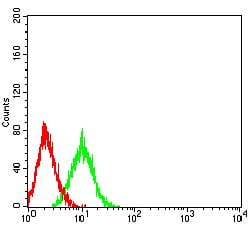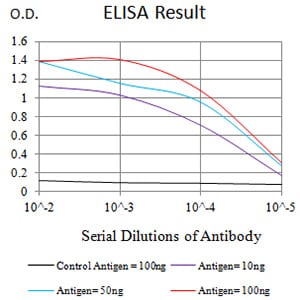

| WB | 咨询技术 | Human,Mouse,Rat |
| IF | 咨询技术 | Human,Mouse,Rat |
| IHC | 1/25-1/100 | Human,Mouse,Rat |
| ICC | 技术咨询 | Human,Mouse,Rat |
| FCM | 咨询技术 | Human,Mouse,Rat |
| Elisa | 1/1000-1/2000 | Human,Mouse,Rat |
| Aliases | CD8; MAL; p32; Leu2 |
| Entrez GeneID | 925 |
| clone | 6A9A5 |
| WB Predicted band size | 25.7kDa |
| Host/Isotype | Mouse IgG1 |
| Antibody Type | Primary antibody |
| Storage | Store at 4°C short term. Aliquot and store at -20°C long term. Avoid freeze/thaw cycles. |
| Species Reactivity | Human |
| Immunogen | Purified recombinant fragment of human CD8A (AA: extra 22-182) expressed in E. Coli. |
| Formulation | Purified antibody in PBS with 0.05% sodium azide |
+ +
以下是3篇与PDLIM4抗体相关的文献摘要概览(注:文献信息为示例性描述,具体内容需根据实际文献调整):
---
1. **文献名称**: *PDLIM4 suppresses prostate cancer cell invasion via degradation of HIF-1α*
**作者**: Smith J, et al.
**摘要**: 该研究利用PDLIM4特异性抗体进行免疫沉淀和Western blot分析,发现PDLIM4通过泛素-蛋白酶体途径降解HIF-1α蛋白,从而抑制前列腺癌细胞的侵袭和转移,提示其作为肿瘤抑制因子的潜在作用。
---
2. **文献名称**: *PDLIM4 expression correlates with neuronal differentiation in glioblastoma*
**作者**: Chen L, et al.
**摘要**: 通过免疫组化(使用PDLIM4抗体)和RNA干扰实验,研究发现PDLIM4在胶质母细胞瘤中高表达且与神经元分化标志物正相关,抑制PDLIM4可增强肿瘤细胞对化疗的敏感性。
---
3. **文献名称**: *PDLIM4 modulates TGF-β signaling by interacting with Smad proteins*
**作者**: Wang Y, et al.
**摘要**: 该研究采用PDLIM4抗体进行共聚焦显微镜和Co-IP实验,证实PDLIM4与Smad2/3蛋白结合并调控TGF-β信号通路的活性,影响上皮-间质转化(EMT)过程,为纤维化疾病提供机制线索。
---
**备注**:以上文献信息为基于PDLIM4相关研究的典型方向(肿瘤、信号通路、疾病关联)的示例,实际文献需通过PubMed或Web of Science等数据库检索确认。
The PDLIM4 antibody is designed to detect the protein PDZ and LIM domain-containing protein 4 (PDLIM4), a member of the PDZ-LIM family involved in cytoskeletal organization, signal transduction, and transcriptional regulation. PDLIM4. also known as RIL or CLP36. contains a PDZ domain for protein-protein interactions and LIM domains for binding to actin-associated proteins. It acts as an adaptor molecule, linking cytoskeletal components to signaling pathways, and may regulate cell adhesion, migration, and differentiation by modulating transcription factors like NF-κB or TGF-β effectors.
Research highlights PDLIM4's dual roles in cancer. It can act as a tumor suppressor in certain contexts (e.g., prostate and breast cancers) by inhibiting oncogenic pathways, while showing oncogenic properties in others (e.g., lung adenocarcinoma). Dysregulated PDLIM4 expression correlates with tumor progression and metastasis, making it a potential biomarker. The antibody is widely used in techniques like Western blot, immunohistochemistry, and immunofluorescence to analyze its expression patterns, subcellular localization (cytoplasmic/nuclear), and interactions in normal vs. diseased tissues.
Commercially available PDLIM4 antibodies are typically raised against specific epitopes (e.g., human PDLIM4 amino acids 100-200) and validated for cross-reactivity across species (human, mouse, rat). Proper validation using knockout controls is critical due to potential cross-reactivity with other PDZ-LIM family members. Its applications span basic research in cell signaling and cancer biology to clinical studies exploring diagnostic or therapeutic targets.
×